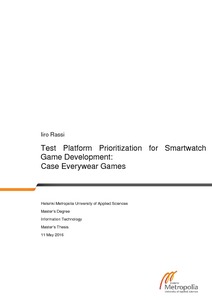Test Platform Prioritization for Smartwatch Game Development : Case Everywear Games
Rassi, Iiro (2016)
Rassi, Iiro
Metropolia Ammattikorkeakoulu
2016

Creative Commons Attribution-NonCommercial-NoDerivs 1.0 Suomi
Julkaisun pysyvä osoite on
https://urn.fi/URN:NBN:fi:amk-201605249420
https://urn.fi/URN:NBN:fi:amk-201605249420
Tiivistelmä
Testing in game development does not follow the same priorities and processes as in common software development. Game testing places a larger emphasis on usability aspects such as the fun-factor of the gameplay. Due to the different quality criteria, the approach to test planning is different as well. This thesis explores the possibility of prioritizing the testing platform based on the testing task at hand in order to improve the efficiency and reduce the resource costs of the test execution.
Testing platforms in this context refer mainly to the simulator provided by the application development software and a real device. The client of the thesis, Everywear Games, develops games for the Apple Watch smartwatch. As a growing company they were interested in building up their processes in the most efficient way.
The primary goal of the thesis was to formulate a set of principles for conducting test platform prioritization in a smartwatch game development project. This goal was fulfilled by the contents of the thesis. There were many discrepancies found between the operation of the simulator and the device, which were categorized as performance, physical and functional differences. These guidelines can be applied to other mobile development projects in other fields as well, if the quality criteria are similar.
The secondary goal was to investigate the testing of a smartwatch game project in a real world environment. This goal was fulfilled by the testing conducted on the client’s game applications. The findings of the investigation supported the theory, and showed no difference in the test results between the simulator and an actual Apple Watch device. This presents the tester with the possibility of selecting the most efficient tool for each testing task. The investigation was conducted with functional tests and, due to the aspects discussed in the theory section, other test types could provide more varied results.
Testing platforms in this context refer mainly to the simulator provided by the application development software and a real device. The client of the thesis, Everywear Games, develops games for the Apple Watch smartwatch. As a growing company they were interested in building up their processes in the most efficient way.
The primary goal of the thesis was to formulate a set of principles for conducting test platform prioritization in a smartwatch game development project. This goal was fulfilled by the contents of the thesis. There were many discrepancies found between the operation of the simulator and the device, which were categorized as performance, physical and functional differences. These guidelines can be applied to other mobile development projects in other fields as well, if the quality criteria are similar.
The secondary goal was to investigate the testing of a smartwatch game project in a real world environment. This goal was fulfilled by the testing conducted on the client’s game applications. The findings of the investigation supported the theory, and showed no difference in the test results between the simulator and an actual Apple Watch device. This presents the tester with the possibility of selecting the most efficient tool for each testing task. The investigation was conducted with functional tests and, due to the aspects discussed in the theory section, other test types could provide more varied results.
